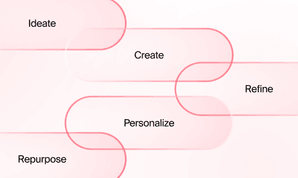AI at Work
50+ Content Marketing Statistics to Watch [2025]

Akshita Sharma · Content Marketing Associate
June 20th, 2025 · 14 min read

Content marketing isn't what it used to be. The days of churning out blog posts and hoping for the best are over. Today's audiences expect content that finds them where they already are — and AI is making that possible at a scale we couldn't have imagined just a couple years ago.
But here's the thing: all this technology only matters if you know what's actually working. We've compiled the statistics from 22 important sources that'll help you make smarter decisions about where to invest your time and budget in 2025.
What you'll learn
What you'll learn
The state of AI in marketing: Over 80% of marketers use AI, and 53% have already reorganized their teams because of it. But 95% of AI pilots fail — we'll show you why and how to avoid it.
Where your time is really going: Marketing leaders waste 15+ hours per week on tasks that could be automated, while campaigns that should take 2 weeks are taking 3-4 weeks due to tool fragmentation.
How search has fundamentally changed: AI Overviews now appear for 10% of keywords, and 89% of their citations come from pages that aren't even in the top 10 rankings. The rules for visibility have been rewritten.
What's working in social and video: YouTube grew 79% in the past year, and AI-generated social content is outperforming human-only content by significant margins.
Why small B2B teams are struggling: 76% have content teams, but 54% have just 2-5 people. The challenge is creating a scalable system that doesn't burn out your team.
The big picture: AI is everywhere (and that's good news)
Let's start with what you're probably already experiencing: AI has gone from "emerging" to essential. Over 80% of marketers worldwide are already using AI in their digital strategies,¹ and nearly 20% are dedicating more than 40% of their budgets to it.¹
The impact is already showing up in how teams operate. According to our Typeface Signal Report, 53% of marketing leaders have reorganized their teams or updated roles and responsibilities because of AI.² That's more than half of all marketing leaders fundamentally rethinking how their teams work.
Why the rush? Because when it's done right, AI solves the biggest challenge in content marketing — creating quality at scale without losing your brand voice or burning out your team. In fact, 95% of marketing leaders say there's rising demand for content, but only 14% feel completely confident they have the tools to keep pace.²
What this means for you: The question isn't whether to use AI anymore. It's about using it strategically. Think of AI as your content creation partner that handles the heavy lifting of first drafts and variations, giving your team back the time to add the human touch that makes content actually connect.
Here's what smart marketers are doing: Nearly half of AI users (49%) are creating complex, multi-step prompts to guide AI toward better results.³ Another 40% use AI for learning and skill-building, while 34% lean on it for research and brainstorming.⁴ The key? They're not just hitting "generate" and calling it a day — 86% still spend time editing AI-generated content to make sure it aligns with their brand voice and quality standards.⁴
The agency spend shift: There's strong evidence that properly implemented AI is changing the economics of content creation. Our research found that 83% of marketing leaders believe fully automating content creation would reduce their agency spend, with 11% saying they'd eliminate agency use altogether.² Even more telling: 73% of teams that have successfully adopted AI agents have already decreased their agency content creation spend, compared to 0% of those who haven't.²
With Typeface, you don't need to become a prompt engineer. Our platform combines specialized AI agents with your Brand Hub — a living system that knows your brand guidelines, assets, and audience preferences, so every piece of content starts closer to finished and stays consistently on-brand.
The hidden problem: Marketers are drowning in busywork
Here's something that might resonate: marketing leaders spend more than 15 hours per week on tasks they believe could be automated.² That's nearly two full workdays lost to busywork instead of strategy.
And it gets more frustrating. While 84% of marketing leaders say their role is more about creativity than project management,² they're stuck managing the chaos instead of doing the creative thinking that actually moves the needle.
The campaign execution challenge is real: 85% of marketing leaders want to launch campaigns in one to two weeks, but 69% say they can't get multi-channel campaigns out the door in less than three to four weeks.² Why? The average campaign involves six different vendors or tools, and three-quarters of marketing leaders juggle between five and eight tools per campaign.²
But here's proof that AI implementation done right makes a tangible difference: 27% of marketers using AI can execute campaigns in two weeks or less, compared to 0% of those not using AI.²
This is where Typeface's orchestrated approach matters. Instead of duct-taping together six different tools, you get campaign ideation, content creation, and channel optimization working together in one platform, cutting weeks off your timeline.
Social media: Where attention lives (but competition is fierce)
Social platforms have become the default hangout spot for most of humanity. Over 62.6% of people worldwide use social media, spending an average of 2 hours and 20 minutes there daily.⁵ Gen Z pushes that even higher at nearly 3 hours per day, and 30% of them turn to social first when looking for inspiration.⁶
The real opportunity: YouTube has exploded as a brand platform, with 79% growth in the past year — outpacing Instagram and Facebook.⁷ Video content isn't just nice to have anymore; it's where audiences are actively choosing to spend their time.
The catch: Creating engaging content, finding fresh ideas, and keeping up with constant platform changes remain the top challenges for social media marketers.⁷ It's exhausting to keep up with the volume and variety audiences expect.
But here's the good news: 71% of social media marketers who use AI tools report that AI-generated content actually outperforms content made without it.⁷ And when you optimize for social search—using relevant hashtags, engaging captions, and searchable content — 86% of marketers say it plays a crucial role in their strategy.⁷
Typeface helps you move fast without sacrificing quality. Create personalized social posts for LinkedIn, X, and other platforms, repurpose long-form content into social snippets with our content blend tools, and generate custom visuals in our Inspiration Studio — all while keeping your brand voice intact across every channel.
Digital Advertising: Bigger Budgets, Tougher Competition
Global digital ad spending is on track to hit $740.3 billion by 2025.⁸ More money flowing in means more noise to cut through, especially when Facebook and Google still control nearly 60% of US digital ad spend combined.⁹
What's working: Google Ads benchmarks show that search network ads average a 3.17% click-through rate, while display network ads average just 0.46%.¹⁰ If you're below these numbers, it's time to rethink your approach — tighter keyword targeting for search ads, and eye-catching creative for display.
What's changing: As Google phases out third-party cookies, 25% of marketers are shifting toward targeted social media ads as an alternative.¹¹ The precision you used to get from cookie tracking? You'll need to find it through platform-specific targeting and first-party data instead.
With Typeface, you can quickly create Google display ads, search ads, and social ads that pull from your product features and brand guidelines. Need to scale? Our Ad Agent takes one parent ad and generates multiple variations across different aspect ratios, channels, and audience segments, so you can test and optimize without rebuilding from scratch each time.
SEO & search: The rules just got rewritten
Here's a stat that matters: 68% of online experiences start with a search engine.¹² That makes SEO non-negotiable. But the way search actually works has fundamentally changed with AI.
Traditional SEO still matters: Google's algorithm looks at over 200 ranking factors,¹² and content on the first page averages 1,447 words.¹² Organizations with advanced SEO maturity see positive impacts, while those with low SEO maturity struggle.¹³ High-ranking pages also tend to load faster,¹⁵ and smart use of meta tags and strategic keyword placement consistently outperform simple keyword stuffing.¹⁵
But AI search changes everything: Google's AI Overviews now appear for nearly 10% of all keywords — and since launching a year ago, they've seen a 116% increase.¹⁶ Here's the kicker: search impressions have risen by over 49%, but click-through rates have dropped almost 30% because people are getting answers directly from AI without clicking through to websites.¹⁶
Even more interesting: 89% of citations in AI Overviews now come from URLs that aren't even in the top 10 search rankings.¹⁶ Google's AI is digging deeper to find authoritative, relevant content rather than just defaulting to whoever ranks highest.
What this means for your content strategy: You need to optimize for being citation-worthy, not just highly ranked. That means creating comprehensive, well-sourced content that demonstrates real expertise. AI Overviews love structured information — 61% include unordered lists, and 12% use ordered lists¹⁸ — because they make information easy to scan and summarize.
Typeface's AI SEO tools optimize your content for both traditional search and AI-powered discovery. We help you create content that's comprehensive, well-structured, and authoritative — the kind that AI overviews cite and humans actually want to read.
B2B marketing: Small teams, big expectations
B2B marketing looks different than it did just a couple years ago. Content marketing continues to be a major budget priority,¹⁹ but here's the reality: 76% of B2B organizations have dedicated content teams, yet 54% of those teams are tiny—just 2 to 5 people.²⁰
The pressure is real: The most common challenge cited by 54% of B2B marketers is lack of resources.²⁰ Meanwhile, 35% say SEO optimization is one of their biggest struggles, and 45% admit they don't have a scalable model for content creation.²⁰
What's working: Email marketing has become one of the top sources for sales and marketing leads, overtaking some traditional channels.¹⁹ That's likely because email allows for personalized, targeted content delivered directly to inboxes, and automation tools make it easier to segment audiences and measure what's working.
Where AI comes in: 81% of B2B marketers used AI tools in 2024, up from 72% the year before.²⁰ But here's a frustrating stat: 38% of marketers say they have technology they're not using to its full potential—up from 30% the previous year.²⁰ The tools are there, but teams struggle to integrate them effectively.
Most popular B2B content formats: Short articles (92%), videos (76%), case studies (75%), long articles (69%), visual content (57%), and e-books or white papers (51%).²⁰
Typeface helps small B2B teams punch above their weight. Our platform creates a scalable content creation model that works across formats—from email campaigns to case studies to SEO-optimized blog posts — all while maintaining quality and brand consistency. No need to hire a bigger team when you can work smarter with the one you have.
Video: The format everyone wants more of
If you're not investing in video, you're leaving attention on the table. Here's why: 85% of video marketers plan to maintain or increase their video spending, and 75% are already using AI tools to help create or edit their content.²¹
How often should you create video? It depends on your size. Small businesses produce a video roughly every 24 days, medium-sized businesses every 4 days, and large businesses every 3 days.²² The bigger you get, the more video your audience expects.
What types of video work best: Live-action leads the pack at 48%, followed by animated videos (24%) and screen-recorded videos (22%).²¹ As for specific formats, video testimonials were the top choice in 2024 (39%), followed by explainer videos (38%), social media videos (34%), and product demos (32%).²¹
Where video lives: Most companies (67%) host videos primarily on their websites, creating galleries of product videos, training content, webinars, podcasts, and original series.²²
Typeface's Video Agent makes video creation faster with AI-powered TikTok script templates and a video clip generator that turns long-form videos into multiple short-form clips. Get more mileage from your existing content while keeping production time manageable.
Why many AI rollouts fail (and how to avoid it)
Here's the uncomfortable truth: 95% of generative AI pilot projects fail.² That's not a typo — nearly all AI pilots never make it to full deployment.
Our Typeface Signal Report uncovered why. The biggest reason? 61% of teams are using AI at the individual level rather than through collaborative systems and platforms.² People are treating AI like another tool they can add to existing workflows instead of recognizing it as a transformation of how the entire team works together.
The specific failure points:
47% of pilots failed because AI didn't integrate with existing technology or processes²
56% cited compliance or legal concerns²
53% lacked technical resources or IT support²
48% ran into governance concerns around brand safety²
48% faced cultural resistance or change management issues²
22% didn't have executive sponsorship to support the rollout²
What actually works: The 72% of teams that successfully deployed AI agents had one thing in common — they focused on high-quality data that resulted in useful AI output.² They also treated AI adoption as a full transformation rather than just tool adoption.
As Jason Ing, our CMO, put it: "Too many AI projects stall in the pilot phase because teams treat them like tools, not transformations. Real ROI only comes when leaders focus on the people side of change, including building trust, new habits, and shared systems that make AI scale across the enterprise."
This is exactly why Typeface is built as an Agentic Marketing Platform, not just another GenAI tool. We provide the brand intelligence, collaborative systems, and workflow integration that help teams move past pilot purgatory into real, scaled adoption.
What actually matters here
These are more than just interesting numbers — they're signals about where content marketing is headed. The brands winning in 2025 are the ones using AI strategically to create more content, faster, without sacrificing quality or losing their voice.
The common thread? Success comes from having systems that scale. Not just tools, but actual workflows that let you move from idea to published content without drowning in revision rounds or brand approval bottlenecks.
That's exactly what Typeface does. We're an Agentic AI Marketing Platform that combines brand intelligence, specialized AI agents, and a collaborative workspace in one place. Our Brand Hub learns everything about your brand — guidelines, assets, audiences, performance data — and our AI agents use that knowledge to create content that's consistently on-brand and optimized for each channel.
Whether you're creating social posts, email campaigns, blog articles, or ad variations, Typeface helps you work at the speed and scale your audience expects while maintaining the quality your brand deserves.
Want to dig deeper into how marketing leaders are approaching AI adoption? Download the full Typeface Signal Report for detailed insights from 200+ marketing leaders on what's working, what's not, and how to avoid the common pitfalls.
Ready to see how these insights translate into action? Explore Typeface's platform and discover how teams are turning content marketing statistics into actual results.
Sources

Share
Related articles

AI at Work
7 Generative AI Use Cases in Enterprise Marketing

Neelam Goswami · Content Marketing Associate
November 12th, 2024 · 15 min read

AI at Work
5 Ways to Get Started with AI for Marketing

Joanna Huang · Sr. Product Marketing Manager
June 5th, 2024 · 5 min read

Product
Mastering Multimodal AI: Connecting Audio, Visual, and Text Across All Mediums and Branding

Sripad Sriram · Product Manager
October 18th, 2023 · 8 min read